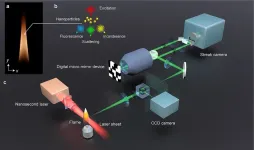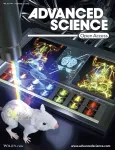(Press-News.org) People who suffer from insomnia were 69% more likely to have a heart attack compared to those who didn’t have the sleep disorder during an average nine years of follow-up, according to new research being presented at the American College of Cardiology’s Annual Scientific Session Together With the World Congress of Cardiology. In addition, when looking at sleep duration as an objective measure of insomnia, researchers found that people who clocked five or fewer hours of sleep a night had the greatest risk of experiencing a heart attack. People with both diabetes and insomnia had a twofold likelihood of having a heart attack.
“Insomnia is the most common sleep disorder, but in many ways it’s no longer just an illness, it’s more of a life choice. We just don’t prioritize sleep as much as we should,” said Yomna E. Dean, a medical student at Alexandria University in Alexandria, Egypt, and author of the study. “Our study showed that people with insomnia are more likely to have a heart attack regardless of age, and heart attacks occurred more often in women with insomnia.”
Dean and her research team are hopeful that the current study will help draw attention to the role that sleep disorders may play in heart health. Insomnia may include trouble falling asleep, staying asleep or getting good quality sleep. Growing in prevalence, insomnia is estimated to affect 10% to 30% of American adults, affecting women more than men. While studies have linked insomnia to cardiovascular and metabolic diseases, this analysis is the largest to date.
“Based on our pooled data, insomnia should be considered a risk factor for developing a heart attack, and we need to do a better job of educating people about how dangerous [lack of good sleep] can be,” Dean said.
For their analysis, the researchers conducted a systematic review of the literature that yielded 1,226 studies—of these, nine studies originating from the U.S., United Kingdom, Norway, Germany, Taiwan and China were selected for inclusion. All told, data for 1,184,256 adults (43% of whom were women) were assessed. The average age was 52 years and 13% (153,881) had insomnia, which was defined based on ICD diagnostic codes or by the presence of any of these three symptoms: difficulty falling asleep, difficulty staying asleep or waking early and not being able to get back to sleep. People with obstructive sleep apnea were not included. Most patients (96%) did not have a prior history of heart attack. Heart attacks occurred in 2,406 of those who had insomnia and 12,398 of those in the non-insomnia group.
Based on the pooled data, there was a statistically significant association between insomnia and having a heart attack after controlling for other factors that could make a heart attack more likely such as age, gender, comorbidities and smoking. This association between insomnia and heart attack remained significant across all subgroups of patients, including younger and older age (<65 and >65), follow-up duration (more or less than five years), male and female sex, and common comorbidities (diabetes, high blood pressure or cholesterol).
“Not surprisingly, people with insomnia who also had high blood pressure, cholesterol or diabetes had an even higher risk of having a heart attack than those who didn’t,” Dean said. “People with diabetes who also have insomnia had a twofold likelihood of having a heart attack.”
Moreover, people who reported five or less hours of sleep a night were 1.38 and 1.56 times more likely to experience a heart attack compared with those who slept six and seven to eight hours a night, respectively. There was no difference in the risk of heart attack between those getting five or less or nine or more hours of sleep a night, Dean said, which supports findings from previous studies that have shown that getting too little or too much sleep can be harmful to heart health. Dean and her team found that patients who slept six hours had a lower risk of heart attack compared with those who slept nine hours.
In a separate analysis, the researchers sought to determine whether individual insomnia symptoms are associated with a higher risk of heart attack. Disorders of initiating and maintaining sleep—that is, trouble falling or staying asleep—were also tied to a 13% increased likelihood of heart attack compared with people without these symptoms.
Non-restorative sleep and daytime dysfunction, however, were not associated with heart attack, suggesting that those who only complain of feeling unrefreshed upon waking up without any lack of sleep aren’t at an increased risk of heart attacks, Dean said.
Based on the findings, Dean said it is important that people prioritize sleep so they get seven to eight hours of quality sleep a night.
“Practice good sleep hygiene; the room should be dark, quiet and on the cooler side, and put away devices. Do something that is calming to wind down, and if you have tried all these things and still can’t sleep or are sleeping less than five hours, talk with your doctor.”
The study had some limitations, including that most of the studies assessed relied on participants self-reporting on sleep behaviors using questionnaires, although heart attacks were validated by medical reports.
This study was simultaneously published online in Clinical Cardiology at the time of embargo lift.
Mohamed Doma, co-author of this study, will present, “Association Between Insomnia and the Incidence of Myocardial Infarction: A Systemic Review and Meta-Analysis,” on Monday, March 6, at 11 a.m. CT / 17:00 UTC in Room 357.
ACC.23/WCC will take place March 4-6, 2023, in New Orleans, bringing together cardiologists and cardiovascular specialists from around the world to share the newest discoveries in treatment and prevention. Follow @ACCinTouch, @ACCMediaCenter and #ACC23/#WCCardio for the latest news from the meeting.
The American College of Cardiology (ACC) is the global leader in transforming cardiovascular care and improving heart health for all. As the preeminent source of professional medical education for the entire cardiovascular care team since 1949, ACC credentials cardiovascular professionals in over 140 countries who meet stringent qualifications and leads in the formation of health policy, standards and guidelines. Through its world-renowned family of JACC Journals, NCDR registries, ACC Accreditation Services, global network of Member Sections, CardioSmart patient resources and more, the College is committed to ensuring a world where science, knowledge and innovation optimize patient care and outcomes. Learn more at ACC.org.
###
END
Rising rates of adverse pregnancy outcomes, such as hypertensive disorders of pregnancy, preterm birth and low birthweight, over the past 10 years are largely attributable to the health status of a person before they get pregnant, rather than age, according to a study presented at the American College of Cardiology’s Annual Scientific Session Together With the World Congress of Cardiology.
The study found that the average age of pregnant individuals rose from 27.9 years in 2011 to 29.1 years in 2019, yet age accounted for only a small portion of the marked increase ...
People who became pregnant using assisted reproductive technologies were found to be over twice as likely to develop preeclampsia than those with traditional pregnancies, according to a study presented at the American College of Cardiology’s Annual Scientific Session Together With the World Congress of Cardiology.
The study, based on an analysis of health records from over 2.2 million patients, is the first to assess how reproductive technologies may affect the risk of cardiovascular complications during pregnancy on a national scale. Preeclampsia is a pregnancy-related complication involving new onset high ...
People who used marijuana daily were found to be about one-third more likely to develop coronary artery disease (CAD) compared with people who have never used the drug, according to a study presented at the American College of Cardiology’s Annual Scientific Session Together With the World Congress of Cardiology.
As cannabis becomes legal in an increasing number of U.S. states, this study is among the largest and most comprehensive to date to examine the potential long-term cardiovascular implications of using the drug. CAD is the most common form of heart disease and occurs when the arteries that supply blood to the heart ...
People with Type 2 diabetes who were given a smartphone app that delivers personalized cognitive behavioral therapy (CBT) saw significantly greater reductions in their blood sugar and less need for higher doses of diabetes medications at six months compared with those who only received standard diabetes care and a control app, in a study presented at the American College of Cardiology’s Annual Scientific Session Together With the World Congress of Cardiology. A clear “dose effect” was seen, with patients completing more CBT lessons seeing the greatest benefits.
“When studied in a large randomized controlled ...
More than 100 years ago, Charles Doolittle Walcott from the Smithsonian Institution was asked to examine strange star-shaped fossils with lobes hailing from the ~ 514-million-year-old Conasauga Formation in Alabama. Walcott described these odd fossils as jellyfish that likely floated in the middle Cambrian seas of what is now the southeastern United States. Little did he know that the Cambrian fossil he named would cause over 100 years of controversy.
The controversy hinged on the interpretation of what Brooksella really was: Was it truly a jellyfish ...
ROCKVILLE, MD – Carlas S. Smith, PhD, of Delft University of Technology, the Netherlands was honored as the recipient of the Biophysical Journal Paper of the Year-Early Career Investigator Award at the 67th Annual Meeting of the Biophysical Society, held February 18-22 in San Diego, California. This award recognizes the work of outstanding early career investigators in biophysics. The winning paper is titled “Precision in Iterative Modulation Enhanced Single-Molecule Localization Microscopy.” The paper was published in ...
Astronomers from the University of Texas and the University of Arizona have discovered a rapidly growing black hole in one of the most extreme galaxies known in the very early Universe. The discovery of the galaxy and the black hole at its centre provides new clues on the formation of the very first supermassive black holes. The new work is published in Monthly Notices of the Royal Astronomical Society.
Using observations taken with the Atacama Large Millimeter Array (ALMA), a radio observatory sited in Chile, the team have determined that the galaxy, named COS-87259, containing this new supermassive ...
By illuminating a sample surface with short laser beam pulses, it is possible to film sequences of various chemical and physical reactions. A research team that included researchers from the University of Gothenburg has now developed the world’s fastest single-shot laser camera, which is at least a thousand times faster than today’s most modern equipment for combustion diagnostics. The discovery has enormous significance for studying the lightning-fast combustion of hydrocarbons.
What happens ...
University of South Australia researchers are calling for exercise to be a mainstay approach for managing depression as a new study shows that physical activity is 1.5 times more effective than counselling or the leading medications.
Published in the British Journal of Sports Medicine, the review is the most comprehensive to date, encompassing 97 reviews, 1039 trials and 128,119 participants. It shows that physical activity is extremely beneficial for improving symptoms of depression, anxiety, and distress.
Specifically, the review showed that exercise interventions ...
It takes a few moments for the sound of thunder to reach our ears after a flash of lightning. This phenomenon is due to the photoacoustic (PA) effect where materials near the lightning instantly expand as the optical energy of the lightning is absorbed and converted into thermal energy. Using this PA effect, photoacoustic computed tomography (PACT) has become a premier preclinical and clinical imaging modality to take images inside the body without using a contrast medium. However, its low-quality images, which can be improved with multiple ultrasound sensors and a multi-channel data acquisition (DAQ) system, ...




